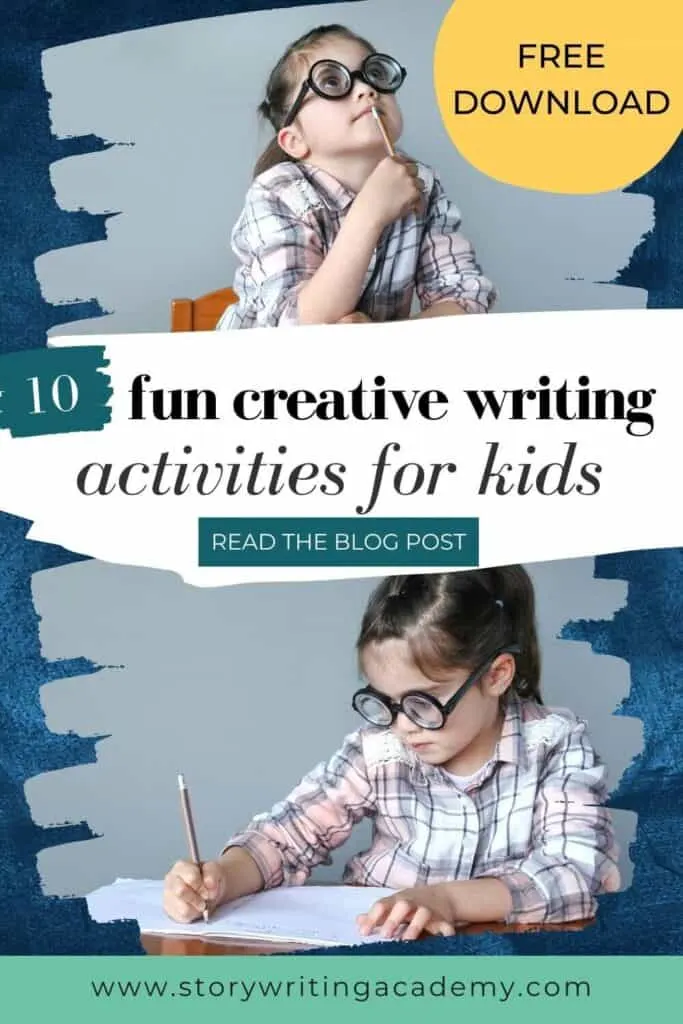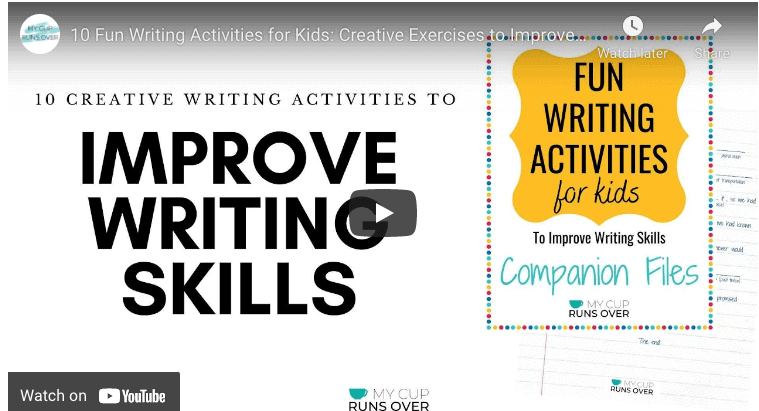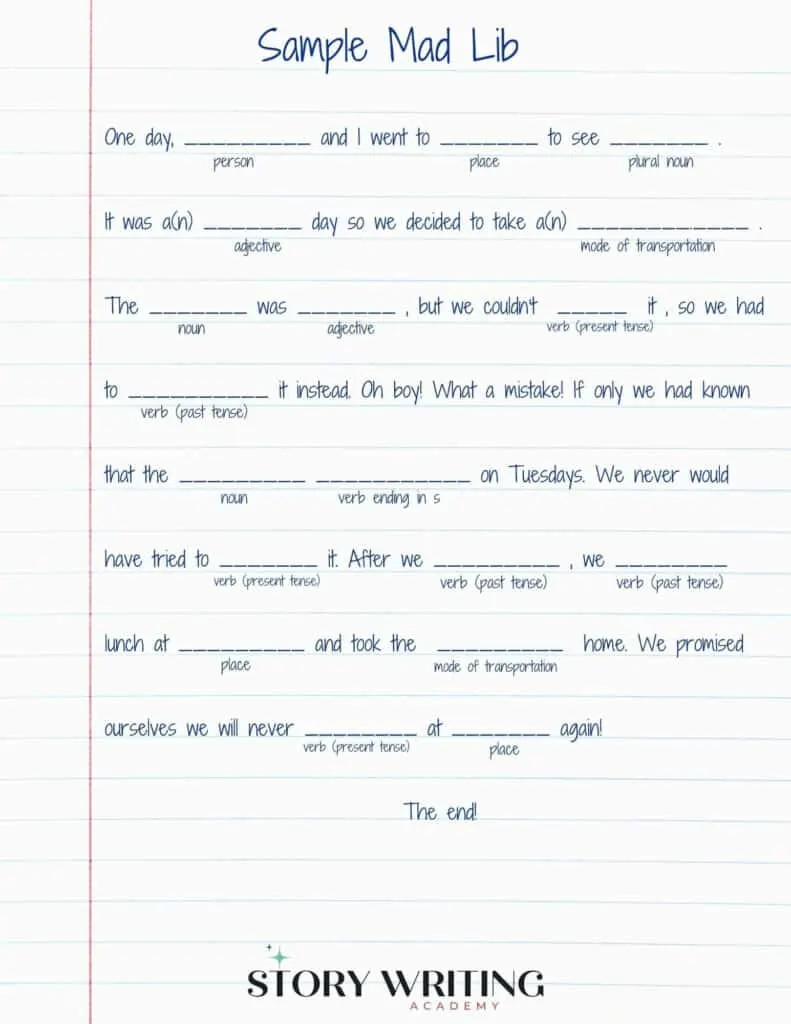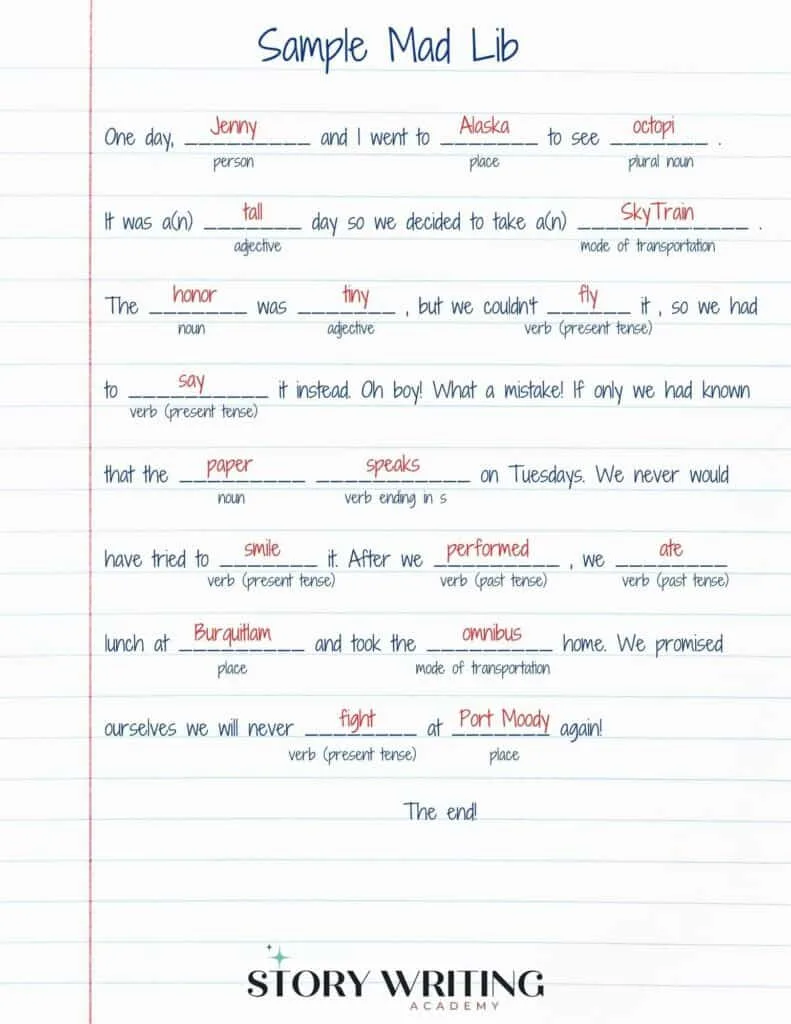Do your students grumble when it’s time to practice writing? Is getting them to write an essay about as much fun as getting grapefruit juice in your eye? Maybe it’s time to try some fun writing activities instead. Here are ten of our favorite fun writing activities for kids.

Breaking Kids out of a Writing Rut
We’ve been through so many stages of learning to write in our homeschool: reluctant writers, frustrated writers, bored writers, curious writers, and obsessive writers (my favorite!).
Over the years, we’ve tried countless writing programs and curricula in a constant effort to keep writing fun and interesting. While we’ve had success stories with a few programs, I find one of the best ways to keep kids engaged with writing is to integrate a fun activity alongside our regular curriculum.
When kids are having fun, they want to write more, which helps them develop stronger creative writing skills and become better writers. Introducing them to different ways of generating creative writing ideas and thinking about writing turns a once-stressful activity into a much-loved pastime.
Here are ten of our favorite ways to make writing fun for kids.

10 Fun Writing Activities for Kids
1. Write a comic book/graphic novel
Using a template, students create their own comic strip or graphic novel complete with speech bubbles and annotations.
First, you’ll need a comic strip template. You can draw your own or allow kids to do so if they choose. Or, download the companion files at the end of this post to grab some pre-formatted templates.

The amount of guidance each student needs will vary depending on their age and ability. By design, comics and graphic novels are straight to the point. They don’t have room for any superfluous content.
Therefore, it’s a good idea to take time beforehand and plan what’s going to happen in the short story, either using a story planner or just jotting down a quick storyboard sketch. They’ll want to have a sense of what’s going to go in each square before they start drawing the pictures in earnest.
Have them draw the pictures first and then add speech and thought bubbles and annotations. If possible, display the finished works so everyone can enjoy them.
Kids are naturally drawn to the comic book or graphic novel format. It’s fun it’s engaging, it moves quickly, and there are lots of pictures.
But the space constraints make it necessary for them to think through their story before they start writing and this is such an important skill to develop. Usually, when we’re writing an essay or a short story, we just write whatever comes into our minds without editing as we go. Often, we write way more than we need to and when we go back to read it later, we find we haven’t even made our point.
Learning how to outline and determine in advance the best way to get a point across is an important skill and creating comic strips is a great way to learn it.
This writing activity can be adapted for any age range, from kindergarten to grade 12. Younger kids may need assistance with printing small letters.
2. Write a Story Together
What it is:
Students work in pairs or groups or with a parent or writing coach to write a short story together.
There are many ways that two or more people can work together to write a short story. The method you choose will depend on who you’re working with, how much time you have, and what your goals are for the activity. Here are a couple of options:
- Writing together: Kids work in pairs or groups (with or without a parent, teacher, or writing coach) to collaborate on each part of the story. Everybody pitches ideas and the group comes to a consensus about them. Kids can take turns acting as the scribe for the group (an adult can do the writing for younger children).
Agree in advance about how you’ll know when the project is finished. Are you aiming for a certain number of words or pages? Or do you just want to see a story with a beginning, middle, and end? Perhaps you want them to practice a specific concept, like seeing how many similes and metaphors they can use.
Determining and articulating the goal ahead of time ensures everyone knows what they’re working towards.
- Writing consecutively. Students take turns writing sections of the story. For example, they might alternate paragraphs or pages, depending on how long it is.
You can either have them agree in advance about the topic and plot points or you could add a twist by not letting them talk about it in advance and having them improvise.
Another variation is to have a group of students working together and have each of them write a sentence or a paragraph of a story and then pass their story on to the person beside them. That person then continues on with that story while the one who started it is continuing on with another person’s story themselves. Continue passing them around in a circle until everyone has added to each story and then can share them with each other.
- Write concurrently: Kids decide on a plot for a story and then divide and conquer. For example, they might come up with a story that has multiple perspectives and have each person can write scenes from a different perspective. After, they can integrate them into a cohesive, well-rounded story.
In my experience, kids love creating stories much more than they actually love writing them, especially when they’re younger. The physical act of getting their thoughts onto paper is time-consuming and because their hands can’t move as fast as their thoughts, kids often get discouraged.
Collaborating with a sibling, a friend, classmates, or adults gives them the immediate reward of progressing in a story without necessarily having to bear the burden of doing all the work themselves.
This writing activity can be adapted for any age range, from kindergarten to grade 12. Lower elementary students should work with a parent, teacher, or writing coach who can guide the collaboration and record the story for them.
For ideas to get you going on your collaborative writing project, check out this huge list of story starters and writing prompts.
3. Retelling a Favorite Story
What it is
Reading or listening to a favorite story and retelling it or rewriting it in their own words.
Ask a student to choose one of their favorite books. For younger kids, this would ideally be a board book or a picture book, while older students might like a chapter book or novel. If choosing a novel, make sure it’s one they’re very familiar with so they don’t need to re-read the whole thing.
(For inspiration on this, or to build out a mini-unit on the topic of retellings, check out this list of Peter Pan retellings).
If it’s a shorter book, read it together. Then, ask the student to either narrate or write down the major parts of the story in their own words.
Another variation: if you have more time, get a big piece of paper or poster board and ask the kids to draw a map of the story. Then, have them draw and cut out pictures of the story’s characters and move them around the map as they tell the story.
Writers learn to write by imitating other writers. Reading a favorite story with the goal of committing its key points to memory is an important step toward becoming a better storyteller. By telling and retelling popular tales, students learn to intuit the elements of a great story and will naturally include those aspects in their own writing.
This writing activity can be adapted for any age range, from kindergarten to grade 12. Students who are not yet reading or writing will need someone to read the story and transcribe their words.
4. The End. Or, The New Beginning.
What it is
Students choose a book they love and give it a new ending or a sequel.
Have students choose a favorite book and decide whether they’re going to rewrite the ending or write a sequel.
Ask them questions to help them give structure to their writing and get their creative juices flowing. Here are some examples:
If re-writing the ending:
- What did you like about the current ending?
- What didn’t you like?
- What questions did you have at the end of the book?
- What event in the story, if changed, would have resulted in a completely different outcome?
- Did the main character get what they wanted or not? What would have happened if they didn’t (or did)?
If writing a sequel:
- Which character(s) in this story did you wish had bigger roles? What else might you have liked to know about their sides of the story?
- What do you think happened after the last chapter of the story?
- What other threats or enemies might still be waiting for the main character?
- Think about the life of the book’s characters at the end of the story. What new character or event might completely topple the balance they’ve found?
Asking students to write a new ending or sequel takes away the pressure of having to come up with an idea from scratch, while still giving them a valuable opportunity to improve their writing skills.
Also, it helps them hone in on the skill of writing endings, which are often the hardest part of the story to write.
This writing activity can be adapted for grades 4 to 12.
5. Dictating a Story
What it is
Dictating a story using voice typing and then editing it
Using a Google Doc, click on the Tools menu and select Voice typing (or press CTRL+Shift+S). Click on the microphone icon and have the student start dictating.
When they’re done, click the microphone again. They can even make changes or fix punctuation as they go without disabling the microphone.
Again, people think much faster than they write or even type.
For emerging writers especially, printing each letter takes so long that by the time they’ve gotten a full sentence down, they may have lost their steam. Being able to dictate the story at the speed they think and talk is highly motivating and puts the focus on idea generation and plot progression, not on the physical act of writing.
Also, this activity gives kids a wonderful opportunity to practice their editing skills.
This writing activity can be adapted for any age range, from kindergarten to grade 12. Younger kids will need help with editing.
6. Create Mad Libs
What it is
Students design Mad Libs for you or for each other
If your students have never played Mad Libs, you will first need to explain this writing game to them and maybe have them do a practice round to get used to the concept. Here’s a sample Mad Lib you can use. It’s also included in the companion files download at the bottom of this post.

Then have them prepare the story. They can either create it from scratch or use an existing text. For example, they might copy out the first paragraph or two of a book. Have them write it on lined paper, double spaced.
Next, they can choose some words to remove from the story. Once they’ve erased the words they want to remove, they should draw a line for the blank word and write a hint under the line to indicate what kind of word is needed.
It’s helpful if they have an understanding of nouns, verbs, adjectives, and adverbs. If they don’t, this is a great time to introduce these concepts. They might also use qualifiers such as ‘something you wear,’ or ‘a job people do.’
Here’s how a finished Mad Lib might look:

When they’re done preparing the story, someone else (a friend, parent, teacher, etc.) gives them the words needed to fill in the blanks. As the respondent gives their answers, the student writes them in the blanks. When all the blanks are filled, the student reads the finished work aloud.
I’ve yet to meet a kid who doesn’t love Mad Libs. They’re such a fun way to approach word choice and sentence structure! Kids get a kick out of making up a really silly story while subtly learning the differences between the various types of words.
This writing activity can be adapted for grades 3-12. Young learners can also enjoy and benefit from Mad Libs, but they aren’t likely to be ready to create their own. Instead, just ask them to provide words for the blank spaces.
7. Custom Printing Pages
What it is
Creating custom writing worksheets for younger kids who are learning to print
I know….I promised fun writing activities. And usually, worksheets are not fun. But I think these ones are different.
My five-year-old doesn’t enjoy practicing her letters and she puts up a huge fight when I ask her to copy things out. Fair enough—learning a challenging new skill is frustrating, even for adults.
But then I discovered this resource. Among the many cool custom worksheets this site can generate, I discovered the customizable printing pages. You can choose the line size, the style of writing, whether you want students to trace or copy, and—most importantly—the text they’ll be copying.
For my daughter, I wrote out a really fun story based on her life but with lots of embellishments and twists. She is the star of the story and she wants to know what happens to her. It took me about five to ten minutes to come up with enough content to fill 27 pages of writing practice sheets (about a month’s worth). I give her one page per day to copy. I haven’t heard a single complaint.
Give it a try. Pick the settings that suit your student(s) best and write a few paragraphs that they won’t be able to stop reading. Then have them trace or copy a small amount each day.
Young learners tend to engage more with the learning process if they think it’s a game rather than a lesson. Who wouldn’t want to read a story starring themselves? (I still have a customized Christmas book my dad ordered for me when I was three!)
It incentivizes them to practice their printing or cursive handwriting by giving them a delightful reward. This is the perfect exercise to do when you’re teaching handwriting.
This writing activity can be adapted for kindergarten to grade 6. For younger learners who need more extensive writing practice, I’m in love with these free printable alphabet worksheets for preschool. This is such a great resource for helping young kids master their letter formation skills.
8. Photographic Writing Prompts
What it is
Writing a story based on an image.
A picture is worth a thousand words, right? And nobody wants to read a thousand-word writing prompt, so why not try photographic writing prompts? This fun story writing activity is simple and can be pulled off with almost no prep time.
First, choose an image you want to display. Then, set a timer. Have everyone (even you) write a story inspired by the picture for fifteen minutes. No planning for this one; this time we’re writing by the seat of our pants. When the timer ends, stop writing. Give students an opportunity to share their stories if they like.

The companion files document at the bottom of this post includes ten fun images you can use as creative writing prompts.
Images are often more inspiring than words and leave more room for interpretation. This, combined with the focus on writing, rather than planning, encourages kids to simply write, rather than fretting about ideas or structure.
Because of the timed and independent nature of this writing activity, it’s best for older children in grades 5 to 12.
9. Convince Me
What it is
Using a creative piece of writing to influence someone’s opinion.
In this writing activity, students create a persuasive piece of writing aimed at convincing you that their favorite thing is the best, i.e. Why Wings of Fire is the Best Dragon Series You’ll Ever Read, or Why Strawberries are the One Fruit We Could All Live On.
Offer suggestions on what format they might choose, but leave the decision up to them. They might write a short essay, a poem, a song, or a rap. Maybe they’ll even decide to create a brochure. Put as few limitations on this final product as possible to encourage maximum creativity.
When they’re done, have them read what they’ve written to try to persuade an audience.
Kids can be highly persuasive, but adults often shut them down when they’re trying to make an argument. For example, every time my daughter says she has a compelling list of reasons why we should let her get a hedgehog, I typically say no immediately without giving her a chance to share her list.
Giving them the opportunity to persuade you about something that matters to them, and to do it in a format they feel comfortable with is an opportunity they won’t want to miss. This fun writing activity also helps them develop their persuasive writing skills. In your feedback, you might offer points on how they can enhance their argument even more.
This writing activity can be adapted for grades 2 to 12.
10. A is for Author
What it is:
Using photos or drawings, along with original writing, to create a new alphabet book.
If possible, go on a nature walk or at least go to a yard or a field. For this writing activity, it’s important that students have many things to observe. Bring notepads and pens or pencils.
Have them try to find one thing for each letter of the alphabet. Allow them to be creative here: ‘eXcess dandelions’ might be a perfect choice to represent X. Have them use their notepads to keep a list of what they’ve found.
Then, set them to work. Let them choose how they will lay their book out. They might use a full page for each letter, a half-page, or a quarter-page. (I’ve included templates for half- and quarter-page layouts) below.

For each letter, they should include a drawing or photograph and a small amount of writing. The writing can be as simple as ‘C is for Crane,’ or it could be more creative, such as a short poem or a paragraph about that thing. Determine how much leeway you’ll give them with the writing component based on their ages and ability.
Have them add a cover page and then assemble their book with staples or by punching holes along the side and tying ribbon or string through each hole.
This fun writing activity works well for both reluctant and eager writers. It takes the focus of writing by including other activities such as walking outside and drawing, while also giving ample opportunity to practice printing (for younger kids) and composition (for older kids).
Eager writers will enjoy the opportunity to add prose or facts to their pages and appreciate the challenge of coming up with something creative for each page.
For this activity, kids may work independently or together, depending on time and preferences. Our family worked together on a single book and it turned out great.
Like most of the creative writing exercises here, this one can be adapted for any age range, from kindergarten to grade 12.
Get the Companion Files
Use the form below to download everything you need to start teaching with these fun creative writing activities for kids today!


z
Monday 2nd of October 2023
Well, can't access anything.... disappointing. I subscribed like 4 times already.
sophie
Thursday 12th of October 2023
can you please email hello @ storywritingacademy.com (remove spaces) and let us know which download you're trying to access? We will send it over to you directly.
Shirin
Thursday 22nd of June 2023
Very innovative ideas inculcate an interest in writing and then working on honing their writing skills
Shruti Shah
Sunday 28th of May 2023
Hi I can't see any form to fill up nor am I getting any access though I have already subscribed Pls help
Thanks
sophie
Thursday 21st of September 2023
The form is at the end of this post, just above where you posted this comment. Thanks.
pliu
Friday 21st of April 2023
where the heck are the comic strip templates. I signed up 3 times!!!!!
sophie
Thursday 21st of September 2023
I'm sorry you are having difficulty. Please feel free to email hello @ storywritingacademy.com if you need help and we can send them to you directly.